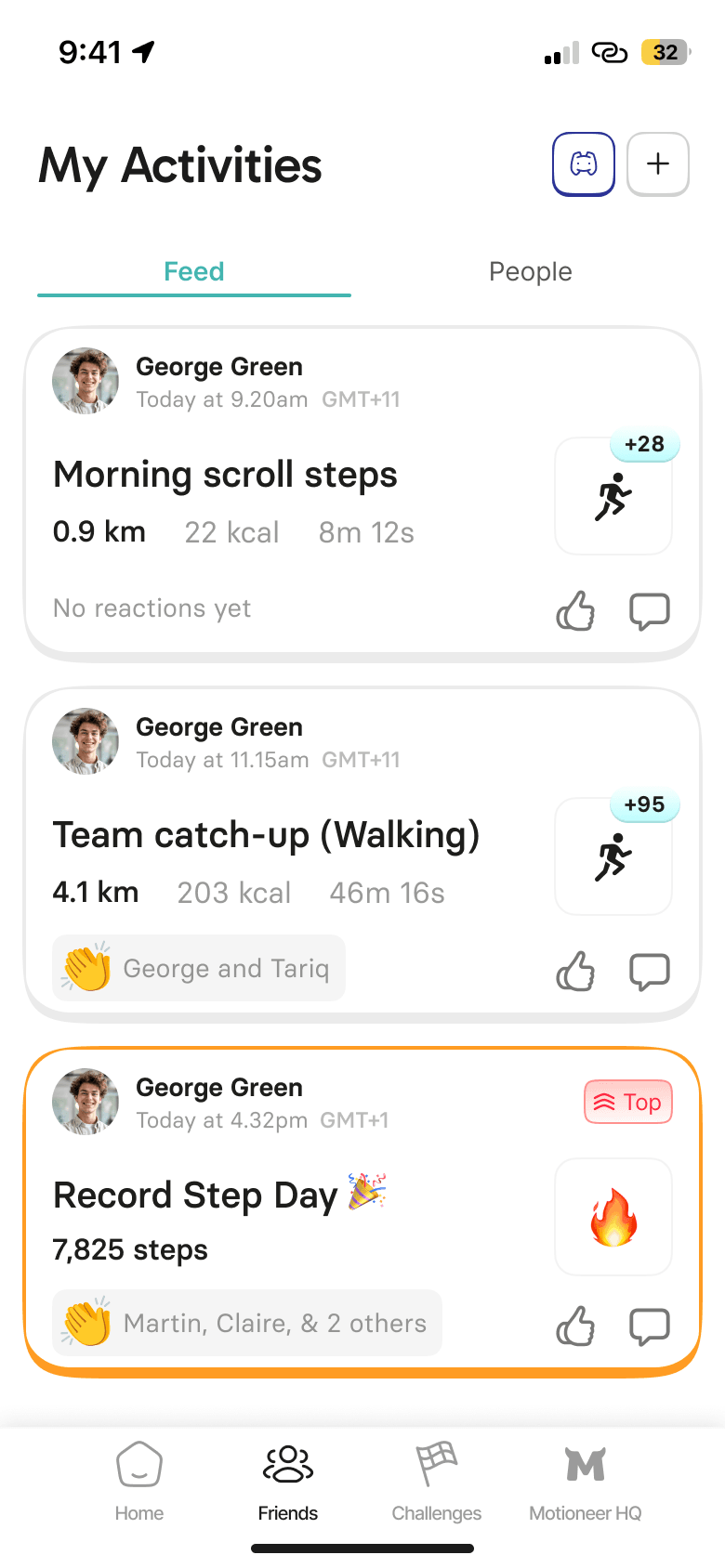How to Actually Hit Your Daily Step Goal (Without It Taking Over Your Life)
Discover simple, science-backed ways to naturally increase your daily steps. No extreme measures, no 2-hour walks, just smart strategies that fit into your existing routine.

Let's Be Honest About Daily Steps
You know walking more is good for you. Your doctor says it, your fitness tracker reminds you, and your body feels it. Yet here you are, averaging 3,000 steps when your goal is 10,000.
Why Boosting Steps Is Harder Than It Sounds
The Time Problem: "Just walk more!" Sure, let me pencil in a 2-hour
walk between work, kids, and that thing called sleep.
The one-size-fits-all goal fiasco: Not everyone's lifestyle allows for
a 10,000-step goal, meaning most people are aiming for goals that weren't
designed for them, and setting themselves up for failure from day 1.
The Weather Excuse: It's too hot, too cold, too rainy, too... outside.
The Motivation Void: Walking in circles around your neighborhood is
mind-numbingly boring.
The All-or-Nothing Trap: Miss your goal Monday? Week's ruined. Try
again next Monday.
The Real Issue: Your Approach, Not Your Ability
The problem isn't that you're lazy or unmotivated. It's that most step-boosting advice treats walking like a separate activity you ADD to your day, rather than something you WEAVE into your existing life.
What if boosting your steps didn't require extra time, supreme willpower, or perfect weather?
What Science Says Actually Works
The Research Is Clear: Small Changes > Big Goals
Stanford behavior scientist BJ Fogg's research on "Tiny Habits" shows that small changes attached to existing routines are more likely to stick than big behavior overhauls.
The Psychology of Successful Step Boosting
Habit Stacking Works: You never forget to brush your teeth because
it's attached to your routine. Apply the same principle to walking -
attach it to things you already do daily.
Gamification Drives Results: Research
published in the
Journal of Medical Internet Research found that gamified fitness apps
significantly increase physical activity levels, with social competition
being particularly effective.
Social Accountability Multiplies Success: Walking with accountability
increases adherence by
65%.
Progress > Perfection: Missing one day doesn't matter. Research shows
flexible goals lead to better long-term adherence than rigid daily
targets.
10 Proven Ways to Naturally Boost Your Daily Steps
1. The Two-Minute Timer Trick
Every hour, when your phone/computer reminds you, walk for just 2 minutes. That's 16 minutes of walking (1,600 steps) in a workday with ZERO extra time commitment. Calculate what these steps mean for you.
2. The Parking Lot Strategy
Park in the furthest spot everywhere. Grocery store, work, gym (ironic, we know). Adds 500-1,000 steps daily without thinking.
3. The Phone Call Pacer
Never sit during phone calls. Pace. Average call is 10 minutes = 1,000 steps. Three calls a day? That's 3,000 bonus steps.
4. The Commercial Break Challenge
Watching TV? Every commercial break = walking time. Average show has 15 minutes of commercials = 1,500 steps per hour of TV.
5. The Bathroom Upgrade
Use the bathroom furthest from your desk. Sounds silly, works brilliantly. 5 trips × 200 extra steps = 1,000 daily steps.
6. The Buddy System
Find someone to compete with using weekly step challenges. Competition increases steps by average of 2,000 daily.
7. The Morning News Walk
Read news/social media while walking instead of in bed. 10 minutes of scrolling = 1,000 steps + better mood to start your day.
8. The Errand Optimizer
Don't optimize for efficiency. Need milk? Walk to the further store. Multiple stops? Park once and walk between them.
9. The Meeting Revolution
Suggest walking meetings for 1-on-1s. Better creativity, fewer PowerPoints, and 3,000+ steps per meeting.
10. The Fake Commute
Work from home? "Commute" around the block before/after work. Creates work boundaries + 2,000 steps.
How to Make These Changes Actually Stick
The Problem With Most Step Advice
Reading tips is easy. Implementing them for more than three days? That's where 90% of people fail.
Why Motion Makes Boosting Steps Automatic
Adaptive Goals That Work With Your Life: Motion's smart goal
system adjusts to YOUR actual patterns.
Busy Tuesday? Your goal knows. Active weekend? It accounts for that.
Gamification That Hooks You: Adopt a virtual
pet that depends on your daily steps. Suddenly,
walking isn't for you - it's for them. Users report this completely
changes their motivation.
Competition Without Embarrassment: Challenge friends where everyone
can win thanks to personalized goals. Your 5,000 steps can beat their
15,000 if you're both pushing yourselves equally.
Every Step Counts: Unlike rigid 10,000-step goals, Motion celebrates
progress. 3,000 yesterday, 3,500 today? That's a win worth celebrating.
Works With What You Have: Any phone or fitness
tracker works. No new device needed. Your
existing step data becomes immediately more motivating.
Frequently asked questions
If you have anything else you want to ask, reach out to us.
How many steps should I aim for daily?
Forget the generic 10,000 steps rule. Research shows health benefits start at just 4,400 steps daily, with diminishing returns after 7,500. Start with YOUR current average and aim to increase by just 500-1,000 steps. Motion automatically sets personalized goals based on your actual activity levels.
What if I don't have time for long walks?
You don't need long walks! The strategies above add steps without dedicated walking time. Two-minute breaks, parking further, and phone call pacing can add 3,000+ steps without scheduling a single 'walk.' It's about frequency, not duration.
Do indoor steps count the same as outdoor steps?
Absolutely! A step is a step, whether it's on a treadmill, pacing your kitchen, or hiking a mountain. Motion counts all movement equally. Your body benefits from movement regardless of location.
How can I stay motivated when the novelty wears off?
This is why gamification and social accountability work. Motion's virtual pets create ongoing emotional investment, while community challenges provide fresh motivation weekly. External motivation bridges the gap until walking becomes automatic.
What's the fastest way to increase my daily steps?
The fastest sustainable increase comes from habit stacking - attaching walking to existing routines. Phone call pacing alone can add 2,000-3,000 steps immediately. But remember: a small sustainable increase beats a dramatic temporary one.
Should I get a fitness tracker to count steps?
Not necessary! Your smartphone already tracks steps accurately (both iPhone and Android have built-in step counters). A fitness tracker can add motivation through convenience, but Motion works perfectly with just your phone.
How long before walking more becomes a habit?
Research suggests 66 days on average for habit formation, but walking habits can form faster (around 3-4 weeks) when tied to existing routines. The key is consistency over intensity. Motion's adaptive goals help by never making the target feel impossible.

